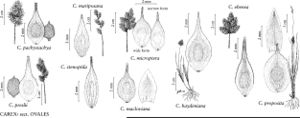Carex preslii
Syn. Pl. Glumac. 2: 242. 1855.
Plants densely cespitose. Culms 23–56 cm. Leaves: sheath adaxially white-hyaline, summits U-shaped to rounded, often prolonged to 6 mm beyond collar; distal ligules 0.8–2.5(–4) mm; blades (2–)3–4 per fertile culm, 6–30 cm × 1.7–3.6 mm. Inflorescences dense or open, green and brown, gold, or brown, 1.4–3 cm × (5–)8–15 mm, stiff, appearing coarse-textured; proximal internode 3–7 mm; 2d internode 1–4 mm; proximal bracts usually aristate, shorter than inflorescences. Spikes 3–7, distant to loosely aggregated, usually individually distinct, narrowly to broadly ovoid, 7–10 × (3–)4.5–7.5 mm, base rounded or attenuate, apex usually acute. Pistillate scales white, gold, red-brown, or chestnut-brown, usually with pale to green midstripe, ovate to broadly ovate, 2.8–3.7 mm, shorter or longer and narrower than perigynia, margin occasionally white, 0.1–0.2(–0.5) mm wide, apex usually acute to acuminate. Perigynia appressed-ascending to ascending-spreading, green or gold, usually green toward beak, contrasting in color with pistillate scales, conspicuously 0–7-veined abaxially, conspicuously 0(–5)-veined adaxially, thin, ovate to broadly ovate, plano-convex or, more often, biconvex, (3.3–)3.5–4.3 × (1.3–)1.5–2 mm, 0.5–0.6(–0.8) mm thick, 2.1–2.7 times as long as wide, margin flat, including wing 0.2–0.4 mm wide, ciliate-serrulate at least on distal body, without metallic sheen; beak gold, gold-brown, red-brown, or brown at tip, flat, ± ciliate-serrulate or cylindric, unwinged, ± entire for 0.6 mm, abaxial suture usually inconspicuous, distance from beak tip to achene 1–2.4 mm. Achenes broadly oblong, ovate, broadly elliptic, or quadrate, 1.5–2 × 1–1.5 mm, 0.4–0.7 mm thick. 2n = 80.
Phenology: Fruiting summer.
Habitat: Open dry to seasonally dry areas
Elevation: 1000–3400 m
Distribution

Alta., B.C., Yukon, Alaska, Calif., Idaho, Mont., Oreg., Wash.
Discussion
Carex preslii has been synonymized with C. pachystachya (A. Cronquist 1969; C. L. Hitchcock and A. Cronquist 1973; A. Cronquist et al. 1972+).
Selected References
None.
